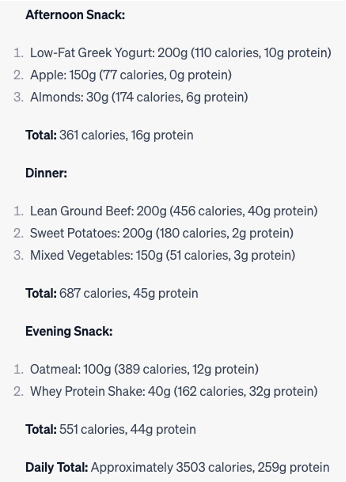If you are like me you are constantly amazed with just the true capabilities of generative AI such as ChatGPT. By the week I am discovering new ways to use AI and have noticed a significant increase in my productivity.
As an athlete my health, fitness and nutrition have always been of very high priority to me. I have been an avid gym goer since I was around 18 years old both to improve my overall sports performance and for health benefits. In the past few years, I have started taking my nutrition more seriously and have noticed a sizeable difference in results. I have in the past experimented with creating my own diet plans and have also used various diet plans found on the internet. Recently, I have started experimenting with ChatGPT to create personalized meal plans and I have been very impressed with the results. It has even brought me to question why someone would pay a personal trainer or nutritionist when all this information with a little bit of practice is right at your fingertips. Hereby, I would like to show how useful AI can be in creating customizable meal plans and how this can be used to make your life easier.
I recently started my “bulk,” with the goal in mind of gaining some weight mostly in the form of muscle in the coming months. I realized in the past that when I do not track what I eat, I simply do not eat enough and do not gain any weight. From experience I know that I need around 3500 calories per day and 200 grams of protein in order to gain weight. Thus, my first input into ChatGPT was:
“Please create me a meal plan of 3500 calories per day and at least 200 grams of protein.”
This resulted in the following output:


Obviously, most people do not want to eat the same food every day, thus my next question was to ask ChatGPT for some alternative meals within a similar caloric range.
Next, to optimize my daily routine, I wanted ChatGPT to base my meal plan around my daily schedule and give me the times in which to consume these meals. The following prompt was used:
“Please base my meal plan on my daily routine and give me the times to consume the meals. I leave for work at 8:30. I go to the gym during my lunch break from 11:45 to 13:00, whereafter I eat lunch comprised of rice, a type of meat (usually chicken) and vegetables. I get home from work at around 18:30.”


Now, not only has ChatGPT provided me with a personalized meal plan based on my caloric needs but it has also provided me with a schedule to consume these meals taking into account my daily work and training routine.
Next, I wanted to take this one step further and I requested ChatGPT to provide me with a weekly shopping list for these items and an overall cost estimation based on average Dutch prices so I can use this to budget my expenses:
“Please provide me with a shopping list that I can purchase the items for the meal plan for 5 days. Also provide ingredients to the alternative meals so that I do not need to consume the same meals every day. Please give me the weight/quantity of the items I need. Also, please approximate the price based on the average prices of groceries in The Netherlands and give me the total costs.”
The tool then provided me with a categorized shopping list and an estimated 5-day cost of 80 – 100 euros which I can easily export to my phone and take with me to the grocery store.
I have been using this for the past few weeks and while I do not exactly use the meals provided by ChatGPT it has given structure and inspiration of foods I can incorporate into my diet. Another advantage of this is that it is infinitely customizable and can be used by everyone. Does a person not consume pork? Is the person a pescatarian? Is the person a vegetarian but still eats chicken? No problem, there are endless possibilities, and this could really make an impact into everyone’s lives. I encourage anyone that is serious about their nutrition and fitness goals to give this a try. This really shows how AI can be used to make everyone’s life easier and increase your overal productivity.
References:
OpenAI (2023). ChatGPT, https://chat.openai.com/

